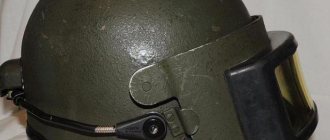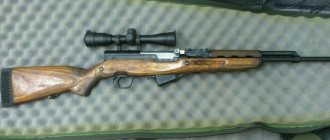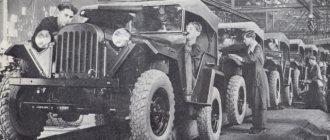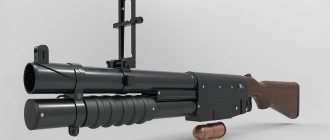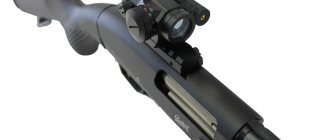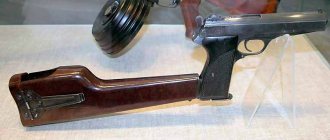Titanium helmet STS-81 Sfera - special forces, Russia 1993
Sfera
(Russian:
Sphere
) (Sfera), officially called
STSh-81
, are bullet-resistant combat helmets made of titanium and steel, manufactured with a protective GOST rating of 2. They are worn by internal troops of the Ministry of Internal Affairs of the Soviet Union and its successor state of Russia. These helmets are still used by police and special forces today.
Back in 1984, the Soviet secret service, the KGB, had titanium helmets developed at military research facilities, which were later used and refined by the FSB and military special forces after the collapse of the Soviet Union. [1]
Unlike most combat helmets, they do not come in one piece, but instead consist of three separate plates: two round ones on the sides of the head and one arched shape that sits on top, extending from the neck to the forehead. [2] These plates are held together by a soft cap with a cord to adjust the size and fit of the plates. The helmet can also be camouflaged using a helmet cover, which is found in patterns such as VSR and Flora. [3]
Titanium Camouflage Helmet Field Green - Russia - Military Special Forces - 1993 - Transport Bag
Versions [edit]
STSH-81 Sphere [edit]
Introduced in 1981, the STS-81 was the first example produced by NPP Classcom, and the material of choice was titanium. STSh-81 helmets have been discontinued. The last year of titanium helmet production was 1993. Production was discontinued due to cost considerations.
SSSH-94 Sfera-S [edit]
The SSH-94 is the successor to the STS-81 and is currently produced by Classcom. Externally similar to its predecessor, the use of steel armor allowed for improved quality and protection at the expense of additional weight (STSh-81 weighs 2.3 kg, and SSSh-94 - 3.3 kg). The SSSH-94 uses the same type of steel as the Mask series helmets.
20th century helmets
The First World War changed everything. Severe trench confrontations and the need to stick your head out and wait out artillery shelling required something more serious on the heads of the soldiers than caps or German leather Pickelhaubes, suitable only for parades.
Soviet and Russian versions of Hadrian's helmet
Source: pinterest.ru
Armies are beginning to develop steel helmets to protect them from shrapnel, shrapnel, solid ground or rocks flying from explosions. They, of course, did not “hold” the bullet. In the Russian Army, at the suggestion of the military attache in France, Colonel A.A. Ignatiev accepts Adrian's French helmet as equipment. The helmet had a characteristic shape with a scallop and a developed visor and backplate, differing from the French one only in the coat of arms. The burning grenada was replaced with a figurine of a double-headed eagle. However, revolutionary events and the Civil War did not allow the “Adrianka” to take root in our troops.
Helmets SSH-36 on fighters
Source: pinterest.ru
And the next thing was only a steel helmet (SS) of the 1935 model - the famous “eared” SSh-36 (marked by the year of delivery to the army), which Budyonny himself chopped with a saber during tests, testing for strength. The SSh-36 had elements inherited from previous models (for example, the scallop), but became a symbol of the pre-war Red Army. Its developed ear and neck protection was somewhat reminiscent of the German Stahlhelm of the 16th year. However, the helmet was a bit heavy and floated a lot when riding a horse, motorcycle or car.
Officers in SSh-40 helmets
Source: pinterest.ru
Therefore, in 1940, it was replaced by a new, very successful one, made from good steel, the SSh-40 - the familiar symbol of our soldiers in the Great Patriotic War. This helmet saved many lives of our soldiers. The helmet went through many tests and existed virtually unchanged in our army until the 2000s. By the way, only slightly modified later versions (for example, SSh-68 and its analogues) were in service not only with the USSR, but also with the Warsaw Pact countries and other countries of the world.
Design description[edit]
The design of the helmet allows for adjustment of the fabric base to fit the size of the head. In the under-helmet part of the helmet, the installation of polyurethane foam dampers was provided to dampen the dynamic impact on the soldier’s head when hit by bullets and shrapnel. The helmet is secured on the head with a strap with a cup, under the chin. Today the helmet has been discontinued, but is still being equipped by the Ministry of Internal Affairs. The lifespan of the helmet is short due to the fragility of the fabric base.
FFP1 class respirators
Protection class FFP1 (Filtering Face Piece) refers to respirators that are used to protect against non-toxic dust and large aerosol droplets. They work better than medical masks, but still do not provide protection against viruses. It is important to consider that if they do not fit tightly, their effectiveness is noticeably reduced. Therefore, men must shave before wearing this mask.
The advantage is that a respirator with a valve moistens much more slowly, therefore, you can wear FFP1 for four to eight hours. This type of respirator is also primarily a protection against touching your face with your hands and not sneezing on others. After taking off the respirator, wash your hands with soap or use a sanitizer.
FFP2 class respirators
Protection class FFP2 is suitable for work in environments with toxic and carcinogenic dust, aerosols, oil and water. This type of respirator, according to experts, can provide protection against the virus in many cases, but does not guarantee it. So, for example, employees potentially in contact with patients and doctors are not recommended to use them. This respirator can be used for six to eight hours. You need to remove it as carefully as possible, without touching the outer part. After taking off the respirator, wash your hands with soap or use a sanitizer.
FFP3 class respirators
This is the most serious class among conventional respirators, followed by filtering gas masks and masks. FFP3 class respirators are required when working with particularly hazardous substances, radioactive materials and when there is a risk of contact with viruses and bacteria. These are the respirators that WHO recommends for use by staff and doctors who come into contact with sick or potentially sick people. Check how many hours of operation the respirator provides. Usually it is six to eight hours.
However, if you decide to go for the maximum level of protection, then a respirator alone will not be enough for you: you must also have safety glasses or a transparent protective shield.
Another problem is that it is difficult to breathe through such a respirator for a long time, and you are unlikely to last six hours in it, and if you take it off, you need to put on a new one. Yes, it’s not easy, but otherwise, using an FFP3 class respirator is pointless and you will simply waste a valuable resource during an epidemic.
Again, you need to remove the respirator as carefully as possible, without touching its outer part. After you take off the respirator, it is advisable to pack it in a plastic bag that must be tied. Then wash your hands thoroughly with soap or use sanitizer.
Photos: Cover, 4 – Sacla, 1 – Prozatochka, 2 – Baucenter, 3 – Gtool
In Blagoveshchensk, a mask regime has been introduced due to the danger of the spread of coronavirus
BANDAGE OR RESPIRATOR?
“In the footage from China, many are no longer even wearing anatomical masks, but in respirators,” says Roman Shantar. — Respirators come in three degrees of protection (see table. — Ed.), their main difference from masks is their tightness. A respirator with the lowest degree of protection is at least 30% more effective than any mask.
But, as in the case of a mask, we are talking about protection from droplets containing viral particles - saliva, mucus, condensation that forms when air is exhaled. “In any case, individual microscopic particles of the virus will penetrate the material of the respirator; even a product with the highest degree of protection cannot stop them,” explains the expert. At the same time, the risk of infection is certainly reduced due to the reduction in the number of penetrating viral particles.
The specialist notes that wearing respirators may be justified in high-risk environments. Like, for example, the current situation in China, where there is a large overcrowding of the population and patients with a new type of coronavirus infection already exist in every region. To prevent colds, flu and in isolated cases of coronavirus importation, using respirators is overkill, doctors say. Moreover, these products have a serious disadvantage. They significantly complicate breathing and therefore may be contraindicated for people with respiratory diseases and cardiovascular diseases.
TO THE POINT
Respiratory protectionRespiratory protection
According to sources in the Russian government, the Ministry of Industry and Trade of the Russian Federation has been instructed to take measures to ensure the required number of masks in pharmacies throughout the country.
Audio: Does a mask really protect against coronavirus?
DO THIS
How to use a medical mask correctly
1. When to put it on
In enclosed spaces where the risk of infection with coronavirus, influenza, and acute respiratory viral infections is increased: airports, clinics, hospitals. And also any rooms where there are sneezing and coughing people nearby (at a distance of 1 - 2 meters).
Attention, error: wear a mask outside. Why? Viruses die quickly in the open air. And when walking, the mask restricts the access of oxygen, which can lead to dizziness and shortness of breath.
2. Lifehacks
— We unfold the folds on the mask for a tighter fit to the face.
— If the mask has a fastener sewn into the nose area, fit it tightly along the back of the nose.
— We straighten the mask so that it covers the nose, mouth and chin.
3. When to change
- If the mask gets dirty, becomes wet from breathing, saliva - immediately.
- In other cases - no later than 2 hours.
! A used disposable mask should be thrown away immediately. Do not wash or reuse.
Read also
Coronavirus in Russia, latest news as of May 13, 2022: No significant increase in incidence observed
We have collected the latest news about coronavirus in Russia on May 13, 2020
How the situation with coronavirus is developing in the Moscow region
The website kp.ru publishes a map of the spread of COVID-2019 by urban districts
The Prosecutor General of Russia ordered strict supervision over payments to doctors
Igor Krasnov demanded that his subordinates immediately respond to all cases of violation of the rights of health workers to receive incentive payments
The number of coronavirus cases in Russia as of May 13, 2022 reached 232,378
We have collected the latest news on the number of coronavirus cases in Russia as of May 13, 2022
"Tricini": The designer made money by combining the colors of a bikini and a mask
Woman's business suffered due to coronavirus restrictions, but she found a creative solution to the problem
The number of people recovered from coronavirus in Russia as of May 13, 2020 was 43,512
We have collected the latest news on the number of people recovered from coronavirus in Russia as of May 13, 2022
How to receive a digital pass in Moscow via SMS during the period of self-isolation: step-by-step instructions
Muscovites can obtain a digital code in different ways
The number of deaths due to coronavirus in Russia as of May 13, 2022 was 2,116 people
We have collected the latest news on the number of deaths due to coronavirus in Russia as of May 13, 2022
Head of Rospotrebnadzor Anna Popova: masks, gloves and disinfection are with us for a long time
The number of children with coronavirus is growing in Russia
Aras Agalarov: At the Crocus hospital they did everything as it should be in an infectious diseases hospital
The famous Russian billionaire told our columnist Alexander Gamov about this
Doctor Myasnikov spoke about the mysterious behavior of coronavirus
A famous doctor and TV presenter noted unusual features of the course of the disease in different people
How to use gloves correctly: five main questions
How long can they be worn and how to remove them correctly?
Coronavirus in Europe and the world, latest news for May 12, 2022: the British were outraged by the “infectious” crowds in the subway on the first day of lifting quarantine
We have collected the latest news about coronavirus in Europe and the world for May 12, 2022
Coronavirus in Sweden, latest news on May 12, 2022: the death toll has exceeded 3,000, the state of emergency has not been introduced
We have collected the latest news about coronavirus in Sweden for May 12, 2020
Is it necessary to wash food and apply ointment to your nose: 7 hygiene questions in the context of coronavirus
British virologists spoke about the benefits of masks and washing food
Leonid Fedun about treatment for coronavirus: I don’t feel very well
The vice president of Lukoil and the owner of Spartak gave his first interview after hospitalization with coronavirus to Komsomolskaya Pravda journalists
Which mask can protect against coronavirus
March 13 at 16:32
Update April 2:
Due to the rapid increase in the number of cases in Russia, more and more doctors are inclined to believe that masks should be worn, because you may be a carrier of COVID-19 and not know it. The incubation period of coronavirus is about two weeks. That is, during this time, even if you become infected, you may not notice symptoms of coronavirus infection.
There is controversy about the benefits of masks during a pandemic, and yet they continue to be actively sold out. The Village looked at recommendations from the WHO, FDA and data from respirator manufacturers and explains which masks and respirators can help and which are useless in the case of coronavirus.
To summarize, masks are more likely to help protect others if you are sick, and respirators will partially protect you if others are sick. Speaking about respirators, it is important to divide them into several classes: these are ordinary medical masks and respirators of classes FFP1, 2 and 3.
To determine the class of a respirator, look at the markings on it, in addition, usually FFP1 has a white or yellow valve, FFP2 has a blue valve and elastic bands, and FFP3 has red elastic bands and a red valve. If the respirator is not marked, use it as FFP1.
Where did the coronavirus come from?
At the wet market where the coronavirus broke out, visitors were treated to raw bat meat.
MEANWHILE
The Russian Ministry of Health recommended three drugs for the treatment of coronavirus
The department also stated that the new coronavirus can cause blood poisoning (details)
Russia limits rail connections with China and closes borders in five regions
Deputy Prime Minister Tatyana Golikova held a meeting of the operational headquarters to combat coronavirus (details)
IMPORTANT
Everything you need to know about coronavirus: symptoms, treatment, prevention
A new type of virus 2019-ncoV was recorded in December last year in China in the city of Wuhan and has adapted for transmission between people. According to scientists, coronavirus is dangerous because it causes the rapid development of pneumonia (details)
